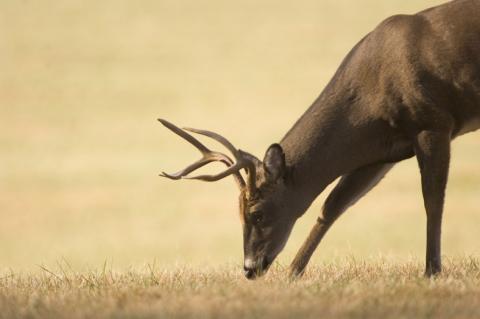Todd Amenrud | Originally published in GameKeepers: Farming for Wildlife Magazine. To subscribe, click here.
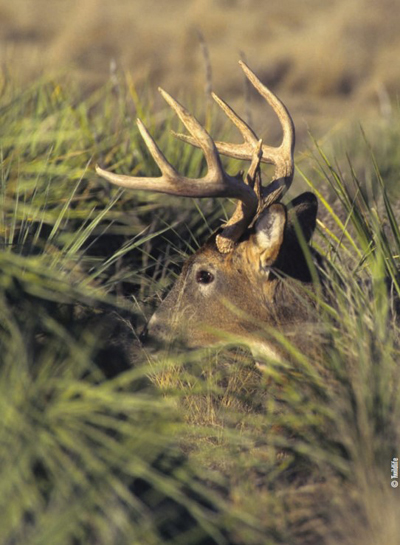
being hunted and they can do some amazing things to
avoid being seen. This buck is hunkering-down in the
weeds to avoid being detected.
The subject of “pressured whitetails” is something most regular hunters know little about. However, the readers of Gamekeepers, in my opinion, are not “average” and most are above the norm with a good understanding of whitetails. With that said, for some reason most still put far too much pressure on their deer herd during the hunting season. Stress only makes hunting whitetails more difficult… and sometimes killing mature bucks seem almost impossible. Forcing whitetails to move through various forms of stress like a “slow push” or an all out “deer drive” are tactics that can be used successfully at times, but for the most part whitetails that are free from stress and don’t know they’re being pursued are by far the easiest to hunt.
We could end this commentary with a simple answer to the question” “Where are mature bucks going to be when they’re pressured?” Answer: wherever you (and other hunters) are not. It’s a bit more detailed than that, but let’s delve deeper into how we should hunt whitetails, or better yet “mature bucks,” if the slightest hint of irritation sends them into a totally nocturnal retreat from their habitual zone and makes them jumpy and ultra-cautious?
Why Let them See your Cards?
Much of my experience hunting pressured deer came early in my hunting career. I was always told that having other hunters around can be good because they can spook deer to you. This was probably told to me because we were hunting public areas and my elders didn’t want me to get discouraged because there were so many other hunters around. Back then, my elders probably believed it too.
While it is true, other hunters certainly can bump deer to you, for the most part you want to hunt deer “without a care in the world,” completely lacking pressure if at all possible. I learned through these attempts (and it seems to me to also be commonsensical) that it’s much easier to hunt whitetails that don’t know they’re being hunted—for two huge reasons.
Both reasons are significant and seem to be common sense to most—first, you are likely to push them into different areas of their home range. You probably won’t move them far, in all likelihood they will stick to their home range. However, now you must start from square one, relocate them and learn their new patterns.
They’ll move to a spot where their needs are met, but they’re no longer being molested. A shelterbelt nobody ever walks down, a small cattail swamp in the middle of a large agricultural field (or, if that ag field is a standing crop that will mostly conceal a whitetail, they may move straight into the ag field) or possibly right into someone’s backyard; they move to spots where they’re not disturbed anymore.
The second big reason pressure is bad is now they know they’re being pursued! Some in the outdoor world fail to assign a “memory” (or certain other brain functions) to animals because they believe a “memory” is solely a human quality and connecting it to an animal apparently gives fuel to the anti-hunters’ fight. “Anthropomorphism” is attributing human characteristics to anything other than a human, please give me a break! On the most basic level—how could a whitetail find their way back to a given food source day after day if they didn’t have some form of a memory. However, I feel it’s MUCH deeper than that. Of course whitetails have a memory! And believe me, they can also think and reason! It’s nowhere near the degree of a humans’ capacity, but I am positive they know when they’re being hunted and they know the best ways to avoid hunters. Every time we enter their turf we teach them new ways how to evade us.
They also learn from other deer—the older deer educate the younger ones on the best ways to avoid danger. They learn the top escape routes to use, the best type of cover to hide in and annual safe zones that don’t get hunted. This happens for generations and if hunters carry on with their same predictable behaviors, whitetails will continue to evade them effortlessly.
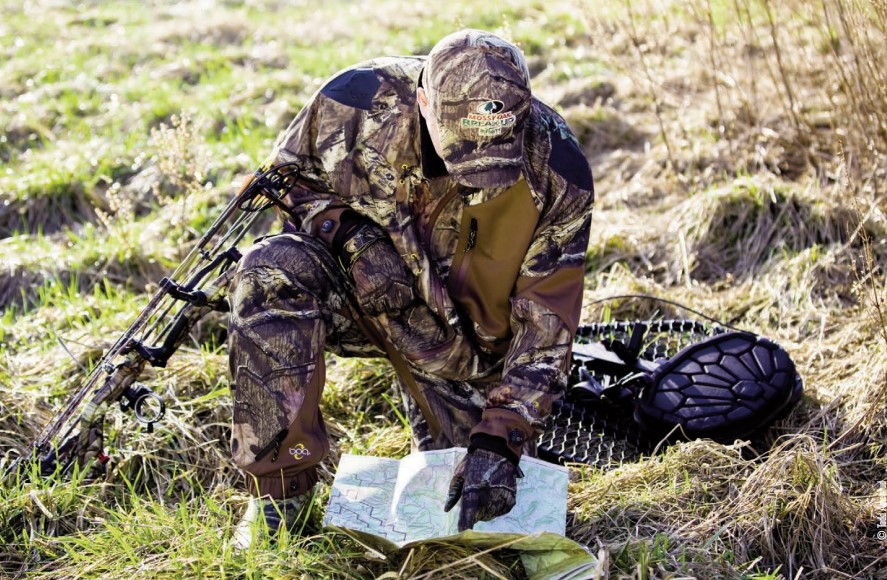
I have seen a blatant example of this on a large public hunting area (Carlos Avery WMA) that I used to hunt near my home. It is made up of long oak savanna ridges with large marshes and cattail swamps dispersed throughout. Every year when hunting pressure began, the deer would vacate the oak ridges and head onto islands dispersed throughout the cattail swamps. Some would also head to private lands surrounding the WMA. The islands were anywhere from about half an acre on up to maybe around five acres in size. It took us a couple years to figure it out, and hunting the islands was a lot of work, but these deer have learned to stay alive by making this short annual transition onto the islands. We would bump the animals off of an island and then set up and wait for their return.
I’ll never forget the sight of legs scampering through the willow brush and cattails, and the sounds of whitetails splashing into the water off the other side when we approached an island. Two things amazed me about these hunts; how quickly they would begin to repopulate the island. In some cases it would only take 15 to 20 minutes before you could hear splashing coming back. And secondly, it taught me that whitetails will sometimes tolerate incredible social pressure when survival is on the line. Both bucks and does and animals of all ages would live in very close propinquity, crammed on a little island. I’ve seen large herds and both sexes together tolerating one another during the winter and spring, but never right around the rut. We killed a few mature bucks this way, but wading for several hundred yards through belly-deep loon-poop with my bow over my head is far too much work for me now.
The Search Begins with Knowledge of Your Quarry
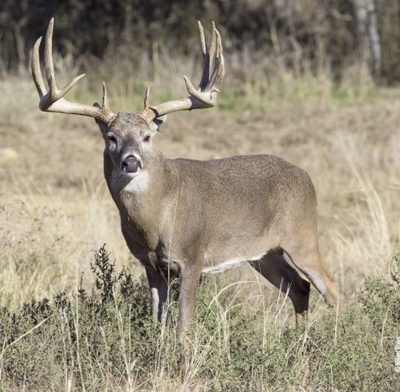
left alone, is important if you wish to see mature bucks like
this up walking around during daylight hours.
Where should we look for whitetails when pressure rears its ugly head? A mature buck’s home range size can vary widely. Much will depend on the type of cover, topography, whether it’s big woods, agricultural or a rural setting, whether it is public or private land, the population density, what type of predator pressure is received and a great deal has to do with the personality of each animal.
We must also understand the difference between “home range” and what is referred to as a “core area,” “secure area” or “seasonal range.” As said, home range size can vary extensively. The annual home range size of an animal in the North that may migrate 20 miles or more from summer range to a wintering area is going to be significantly larger than one in the South that may use the same general area for both a summer and winter home.
Bucks will have a larger “annual home range,” and then depending upon their needs throughout the course of the year they will make seasonal moves to smaller “core areas” that meet those needs at that time of year. Bucks will also typically have a larger home range size than the does. The closer they can find quality food, cover and water, the smaller the average size of their core area and thus their home range will be.
This is why managing whitetails (food plots, herd management and habitat management) can make such a big difference in carrying capacity. If you supply their needs, you decrease the average home range size of every animal whose home range encompasses your efforts. In turn, you notably raise the potential carrying capacity.
Why make it difficult to hunt these animals by putting pressure on them. What is considered “pressure?” In my view, pressure in this capacity is anything that displaces them from their core area or educates them to the fact they’re being hunted. Hunting them when the conditions aren’t in your favor is the biggest mistake people make.
“It’s hunting season and you’ve got the day off of work”…that’s as far as the majority of hunters think. They don’t consider the wind, thermal, approach factors along with other details and consequently they blow the whole deal before they ever see the buck they’re after. “When to hunt” should be executed more like a chess match, you want to think five moves ahead. You should NOT hunt because you can, you should hunt because you should. Hunt when the time is right and the conditions are in your favor. I understand those who have limited opportunities to hunt, but if harvesting a mature buck is the goal, that’s the way it should be. Products like Scent Killer will certainly help to cover some mistakes, but for consistent success you must pay attention to this fact and hunt them only when the circumstances are mostly in your favor.
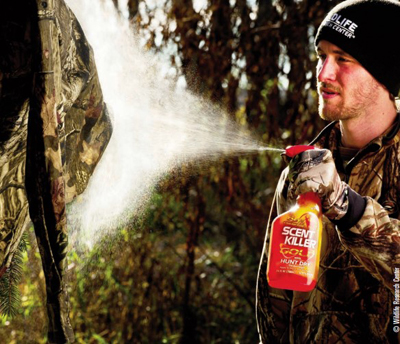
mistakes we make; however, one should only attempt to hunt
when the conditions, especially the wind, thermal and approach
details are in their favor.
Sanctuary, Safety, Security, Space or Shelter
You pick the “S-word” and whitetails will congregate. One of the most effective ways to combat pressure is to simply give them a place where they are left alone. A sanctuary can be effective whether you manage your own property or hunt the same piece public ground year after year. If you wish to observe undisturbed, natural behavior, they need to have an area where they can retreat from pressure and live anxiety-free. When properly put into practice, sanctuaries should help you to witness mature bucks moving without restraint during daylight hours. These animals are much easier to hunt than those that have been displaced due to pressure and now are much more wary and moving primarily after dark.
How big does a sanctuary need to be? Any ground you can devote to refuge is good. Five acres is all it takes to “house” a mature buck, but the bigger the better. Because of the social pressures associated with whitetails living in close proximity to one another, larger sanctuaries of 20 to 40 acres or more tend to be more effective. Sanctuaries can be several hundred acres or more in magnitude.
A very high percentage of acreage is devoted to sanctuary on the properties that I oversee. On my Ontario property, for example, approximately 82 percent of the property is sanctuary. We have smaller pockets that we hunt, but you can expect to witness just as much movement during midday as you do near sunup or sundown. We make numerous exceptions to the rule, but to sum it up, “we don’t harass our whitetail herd.” We hunt when the conditions are in our favor and when we can approach the site undetected.
On my home property in Minnesota, we treat the entire property as a sanctuary. Most ambush locations are set up ahead of the season and hunted sparingly throughout the season. I would estimate I hunt my home property only 6 to 8 times throughout the season, but I can’t remember a time when I didn’t have great action. Because of this lack of pressure (and several other reasons), our density grows throughout the season. We have almost three times as many whitetails in January as we do in September. I still spend more time than the average hunter trying to get close to mature bucks, but it’s spent gathering intelligence, scouting, practicing, making improvements to the property and preparing for when the conditions are in my favor and the time is correct to strike.
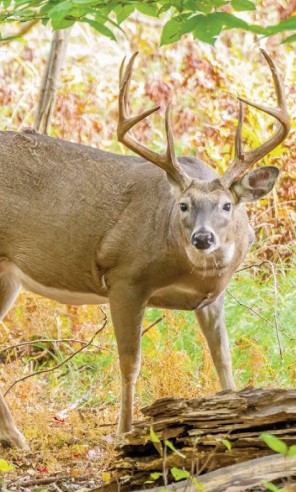
where bucks may go when pressure is
applied and studying maps to learn escape
routes are all important if you wish to come
in contact with bucks like this.
“X” Marks the Spot
How often do you look at maps to make a plan? To figure out where whitetails are going once pressure is applied you must look at maps. Most hunters never venture over 100 yards off of the nearest road or trail. In some cases that may be all you need to know —maybe you only need to move several hundred yards past them, deeper into the cover to find the deer.
Search your maps for the places whitetails will receive the least amount of pressure, that’s where you’ll want to be also—thick, nasty cover, protected private ground, areas difficult for humans to access (but where whitetails will have no problem). Again, the animals want to be wherever you (and other hunters) are not.
Some of the most valuable clues found on maps are funnels, bottlenecks, pinch-points, or whatever you’d like to call them. Wherever you can restrict movement to a smaller zone you will not only see increased traffic, but it’s also easier to position yourself within that zone to remain undetected from their nose. Try to anticipate when the pressure will hit and be waiting for them on these funnels leading to thick cover. Opening weekend of either bow season or gun season are prime-times for these “pressure pinch-points.” Anticipate when mushroom pickers, small game hunters or hikers will hit the outdoors, these are great times to play these escape routes.
Wrapping-up
Once they experience pressure, whitetails can be found where you can’t go, where you don’t want to go, or where you haven’t thought of going. They’ll be found in the most “pressure-free” spot in the area where they can still receive their other needs of food, water and cover. And remember, the cover only needs to be enough to mostly conceal a whitetail’s body.
I’ve been fortunate to hunt in many different states with all sorts of terrain and I really can’t think of a more adaptable animal than the whitetail. When stressed, I’ve seen them run up inclines that I couldn’t scale without mountain climbing gear, and to stay unknown to humans, bed in an old abandoned barn, crawl on their knees and belly down a dried up creek bed to sneak past a hunter on stand, bed in crops like flax, brassicas, corn or any crop that mostly will conceal a bedded whitetail, and hold-up so close to areas with high human traffic like homes, restaurants and parks that most would never think of looking for them there. To find pressured mature bucks one must think out of the box, do their homework and possibly put forth a bit more effort than the average hunter and results will follow.

















